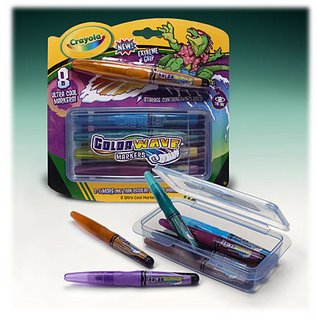TTAB Waves Good-bye to "COLOR WAVE" in Colorless 2(d) Appeal
Can you guess how this appeal turned out just from the basic facts: Applicant's mark COLOR WAVE for markers [COLOR disclaimed] was refused registration due to confusing similarity with COLORWAVE for art paper? Yep, affirmed: marks virtually identical, and goods related, both inherently and in view of third-party registration evidence. In re Binney & Smith Inc., Serial No. 78472642 (December 18, 2006) [not citable].

Applicant Binney & Smith lamely argued that Registrant's mark is "inherently weak" in light of the descriptive meaning of "color," pointing to its own disclaimer and to a list of third-party registrations. The Board was not impressed. The disclaimer has "no legal effect" on the likelihood of confusion issue. And a mere list of registrations is not sufficient to make the registrations of record (and even if it were, the two marks at issue are still virtually identical, whether or not the registrations showed the word "color" to be a weak formative).
Turning to the goods, B&S feebly asserted that they are "of a different character and nature and are 'appreciably different' products." The Board, however, noted that the goods are "inherently related," and the PTO's third-party registration evidence slammed the lid closed on Applicant's crayon box.
Finally, B&S offered two arguments that are guaranteed losers: that the absence of evidence of the fame of the cited mark and the absence of evidence of actual confusion are factors weighing in its favor. Wrong. As to fame, the Board "would not expect the examining attorney to submit evidence of fame of the cited mark." As to confusion, the subject application is based on intent-to-use, and so "we have no information as to whether a meaningful opportunity for actual confusion has occurred."
The Board therefore unsurprisingly affirmed the Section 2(d) refusal.
Text Copyright John L. Welch 2007.




0 Comments:
Post a Comment
<< Home